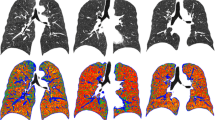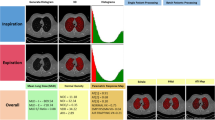Abstract
Background
Lung cancer screening CT scans might provide valuable information about air trapping as an early indicator of smoking-related lung disease. We studied which of the currently suggested measures is most suitable for detecting functionally relevant air trapping on low-dose computed tomography (CT) in a population of subjects with early-stage disease.
Methods
This study was ethically approved and informed consent was obtained. Three quantitative CT air trapping measures were compared against a functional reference standard in 427 male lung cancer screening participants. This reference standard for air trapping was derived from the residual volume over total lung capacity ratio (RV/TLC) beyond the 95th percentile of predicted. The following CT air trapping measures were compared: expiratory to inspiratory relative volume change of voxels with attenuation values between −860 and −950 Hounsfield Units (RVC−860 to −950), expiratory to inspiratory ratio of mean lung density (E/I-ratioMLD) and percentage of voxels below −856 HU in expiration (EXP−856). Receiver operating characteristic (ROC) analysis was performed and area under the ROC curve compared.
Results
Functionally relevant air trapping was present in 38 (8.9 %) participants. E/I-ratioMLD showed the largest area under the curve (0.85, 95 % CI 0.813–0.883), which was significantly larger than RVC−860 to −950 (0.703, 0.657–0.746; p < 0.001) and EXP−856 (0.798, 0.757–0.835; p = 0.002). At the optimum for sensitivity and specificity, E/I-ratioMLD yielded an accuracy of 81.5 %.
Conclusions
The expiratory to inspiratory ratio of mean lung density (E/I-ratioMLD) is most suitable for detecting air trapping on low-dose screening CT and performs significantly better than other suggested quantitative measures.

Similar content being viewed by others
References
Aberle DR, Adams AM, Berg CD et al (2011) Reduced lung-cancer mortality with low-dose computed tomographic screening. N Engl J Med 365:395–409
Sox HC (2011) Better evidence about screening for lung cancer. N Engl J Med 365:455–457
Barnes PJ (2007) Chronic obstructive pulmonary disease: a growing but neglected global epidemic. PLoS Med 4:e112
Rabe KF, Hurd S, Anzueto A et al (2007) Global strategy for the diagnosis, management, and prevention of chronic obstructive pulmonary disease: GOLD executive summary. Am J Respir Crit Care Med 176:532–555
McDonough JE, Yuan R, Suzuki M et al (2011) Small-airway obstruction and emphysema in chronic obstructive pulmonary disease. N Engl J Med 365:1567–1575
Nakano Y, Muro S, Sakai H et al (2000) Computed tomographic measurements of airway dimensions and emphysema in smokers. Correlation with lung function. Am J Respir Crit Care Med 162:1102–1108
Nakano Y, Wong JC, de Jong PA et al (2005) The prediction of small airway dimensions using computed tomography. Am J Respir Crit Care Med 171:142–146
Matsuoka S, Kurihara Y, Yagihashi K, Hoshino M, Watanabe N, Nakajima Y (2008) Quantitative assessment of air trapping in chronic obstructive pulmonary disease using inspiratory and expiratory volumetric MDCT. AJR Am J Roentgenol 190:762–769
Yamashiro T, Matsuoka S, Bartholmai BJ et al (2010) Collapsibility of lung volume by paired inspiratory and expiratory CT scans: correlations with lung function and mean lung density. Acad Radiol 17:489–495
Lee YK, Oh YM, Lee JH et al (2008) Quantitative assessment of emphysema, air trapping, and airway thickening on computed tomography. Lung 186:157–165
Regan EA, Hokanson JE, Murphy JR et al (2010) Genetic epidemiology of COPD (COPDGene) study design. COPD 7:32–43
O’Donnell RA, Peebles C, Ward JA et al (2004) Relationship between peripheral airway dysfunction, airway obstruction, and neutrophilic inflammation in COPD. Thorax 59:837–842
van Iersel CA, de Koning HJ, Draisma G et al (2007) Risk-based selection from the general population in a screening trial: selection criteria, recruitment and power for the Dutch-Belgian randomised lung cancer multi-slice CT screening trial (NELSON). Int J Cancer 120:868–874
Miller MR, Crapo R, Hankinson J et al (2005) General considerations for lung function testing. Eur Respir J 26:153–161
Stocks J, Quanjer PH (1995) Reference values for residual volume, functional residual capacity and total lung capacity. ATS Workshop on Lung Volume Measurements. Official Statement of The European Respiratory Society. Eur Respir J 8:492–506
van Rikxoort EM, de Hoop B, Viergever MA, Prokop M, van Ginneken B (2009) Automatic lung segmentation from thoracic computed tomography scans using a hybrid approach with error detection. Med Phys 36:2934–2947
Schilham AM, van Ginneken B, Gietema H, Prokop M (2006) Local noise weighted filtering for emphysema scoring of low-dose CT images. IEEE Trans Med Imaging 25:451–463
Yuan R, Nagao T, Pare PD et al (2010) Quantification of lung surface area using computed tomography. Respir Res 11:153
Jain N, Covar RA, Gleason MC, Newell JD Jr, Gelfand EW, Spahn JD (2005) Quantitative computed tomography detects peripheral airway disease in asthmatic children. Pediatr Pulmonol 40:211–218
DeLong ER, DeLong DM, Clarke-Pearson DL (1988) Comparing the areas under two or more correlated receiver operating characteristic curves: a nonparametric approach. Biometrics 44:837–845
Coxson HO, Rogers RM, Whittall KP et al (1999) A quantification of the lung surface area in emphysema using computed tomography. Am J Respir Crit Care Med 159:851–856
Mets OM, Willemink MJ, de Kort FPL et al (2012) The effect of iterative reconstruction on computed tomography assessment of emphysema, air trapping and airway dimensions. Eur Radiol 22(10):2103–2109
Mets OM, Buckens CF, Zanen P et al (2011) Identification of chronic obstructive pulmonary disease in lung cancer screening computed tomographic scans. JAMA 306:1775–1781
Han MK, Agusti A, Calverley PM et al (2010) Chronic obstructive pulmonary disease phenotypes: the future of COPD. Am J Respir Crit Care Med 182:598–604
Agusti A, Calverley PM, Celli B et al (2010) Characterisation of COPD heterogeneity in the ECLIPSE cohort. Respir Res 11:122
Gierada DS, Yusen RD, Pilgram TK et al (2001) Repeatability of quantitative CT indexes of emphysema in patients evaluated for lung volume reduction surgery. Radiology 220:448–454
Peduzzi P, Concato J, Kemper E, Holford TR, Feinstein AR (1996) A simulation study of the number of events per variable in logistic regression analysis. J Clin Epidemiol 49:1373–1379
Acknowledgments
Outside the submitted work, MP declared to have received research Grants from Philips Medical Systems and Toshiba Medical Systems, as well as payments and travel expenses for various lectures on CT and CTA.
Conflict of interest
The authors declared no conflicts for the work under consideration.
Author information
Authors and Affiliations
Corresponding author
Rights and permissions
About this article
Cite this article
Mets, O.M., Zanen, P., Lammers, JW.J. et al. Early Identification of Small Airways Disease on Lung Cancer Screening CT: Comparison of Current Air Trapping Measures. Lung 190, 629–633 (2012). https://doi.org/10.1007/s00408-012-9422-8
Received:
Accepted:
Published:
Issue Date:
DOI: https://doi.org/10.1007/s00408-012-9422-8




